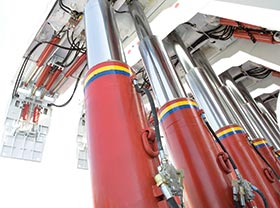

In a cylinder circuit using space-saving cartridge logic elements to emulate a four-way directional valve function, minimising decompression shock when changing from extend to retract can be a challenge. The larger the volume of oil being compressed, the larger the cylinder bore or stroke and the larger the shock potential from the stored hydraulic energy.
Not only is it disconcerting to witness a large piece of equipment react as pressure is relieved uncontrollably, but the shock to the system also drives up cost of ownership, reducing cylinder life, destroying seals, increasing downtime and subjecting expensive machinery, operators and passengers to unnecessarily rough treatment.
Stored energy in the cap end of a cylinder is inevitable. Additionally, the machine frame and product being compressed can substantially increase the total stored energy. The goal is to release this energy in a controlled and consistent manner in the shortest time possible using an acceptable decompression rate for the system.
Some solutions introduce their own problems. Dedicated decompression circuit components – staged-pilot-ratio check valves, orifices and solenoid valves controlled using electrical time-delay logic – can be expensive, unreliable and inconsistent, while adding to cycle time.
Unbalanced logic elements are commonly applied in this situation, with the logic element helping to control the release of energy from the system and reducing shock. The issue with using widely available unbalanced logic elements is that as pressure increases on the load-holding port, the pilot pressure required to operate the valve increases.
This means that to use unbalanced logic elements effectively, it is necessary to be able to predict accurately the pressure on these valves throughout the operational cycle. Knowing this, the necessary pilot pressure can then be calculated to make sure there is always enough pressure to actuate the logic valves; but the problem is that these calculations are difficult to nail down in a real-world system.
A simpler solution uses balanced logic elements, which are unaffected by load-induced pressure on the working ports. The same pilot pressure can be used to operate the valve throughout the operating cycle; and there is a more consistent release of energy than with an unbalanced valve, resulting in a well behaved machine.
By using Sun’s DK*R balanced logic elements with a 2-way DAAL-*CN pilot valve and PRDB pressure reducer/reliever, it is possible to get a zero-leak, reliable, cost-effective, cap-end-to-tank, normally closed logic element. For normally open, the DO*R cartridge can be used in place of the DK*R.
Either cartridge can also include Sun’s T-8A cavity in the cartridge itself – models DK*R-8 and DO*R-8 – to accommodate the pilot control function within the cartridge body. This results in a single, integrated part to further simplify the design.
The T-8A cavity solution is Sun Hydraulics’ unique approach to achieving a wide range of distinctly different control functions. With careful consideration of the individual functions of both the pilot- and main-stage elements, the end-user can build a customised control solution using standard components. The T-8A cavity principle provides solutions that can more precisely match control criteria.
The main stage element provides the main functionality of the two-cartridge combination. Sun’s 95 unique main stage cartridges with integrated T-8A cavities provide relief, reducing sequence, logic, directional and flow control functions. Combined with the right T-8A pilot valve, it is possible to realise accurate, high speed control at extremely high capacities.
The pilot cartridge provides the control method for the main stage element and can be anything from manually actuated switching elements to high speed digital logic valves. There are thirteen different Sun T-8A cartridges that are recommended for piloting large main stages, covering directional control, pressure control, proportional pressure control and flow control.
Since this product is balanced, operating pressures on the work ports do not affect the opening speed of the valve. A typical poppet-style logic element exposes more and more area as the poppet moves to the open position, with the attendant increase in opening force. So by adjusting the pilot pressure via the reducer, an acceptable and repeatable opening time can easily be set. This solution minimises decompression shock in the shortest time with consistent results. Use of the newer soft-shift, 2-way DAAL-SCN as the pilot valve can further enhance tuning for shock reduction.
For more information contact Fritz Kern, Axiom Hydraulics, +27 (0)11 334 3068, [email protected], www.axiom.org.za
| Tel: | +27 11 334 3068 |
| Email: | [email protected] |
| www: | www.axiomsa.co.za |
| Articles: | More information and articles about Axiom Hydraulics |

© Technews Publishing (Pty) Ltd | All Rights Reserved